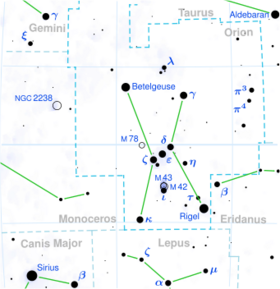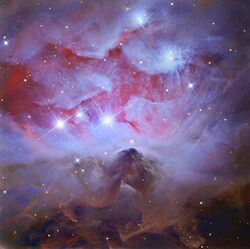Astronomy:42 Orionis
From HandWiki
Short description: Star in the constellation of Orion
| Observation data Equinox J2000.0]] (ICRS) | |
|---|---|
| Constellation | Orion |
| Right ascension | 05h 35m 23.16427s[1] |
| Declination | −4° 50′ 18.0881″[1] |
| Apparent magnitude (V) | 4.59[2] |
| Characteristics | |
| Spectral type | B1V[3] |
| U−B color index | -0.94[2] |
| B−V color index | -0.19[2] |
| Astrometry | |
| Radial velocity (Rv) | +28.40[4] km/s |
| Proper motion (μ) | RA: +4.52[1] mas/yr Dec.: -7.11[1] mas/yr |
| Parallax (π) | 3.69 ± 1.20[1] mas |
| Distance | approx. 900 ly (approx. 270 pc) |
| Details | |
| Mass | 12.0[5] M☉ |
| Radius | 15.6 R☉ |
| Luminosity | 10737 L☉ |
| Temperature | 25,400[6] K |
| Rotational velocity (v sin i) | 20[7] km/s |
| Other designations | |
| Database references | |
| SIMBAD | data |
42 Orionis is a class B1V[3] (blue main-sequence) star in the constellation Orion. Its apparent magnitude is 4.59[2] and it is approximately 900 light years away based on parallax.[1]
The primary star, Aa, has one spectroscopic companion Ab of magnitude 6.3 and separation 0.16", and a more distant companion B of 7.5 magnitude at 1.6" separation.[8][9]
c Orionis is surrounded by NGC 1977 one of a smaller fainter group of named nebulae just north of the Orion Nebula. c Ori is the star which excites and illuminates NGC 1977.
References
- ↑ 1.0 1.1 1.2 1.3 1.4 1.5 Van Leeuwen, F. (2007). "Validation of the new Hipparcos reduction". Astronomy and Astrophysics 474 (2): 653–664. doi:10.1051/0004-6361:20078357. Bibcode: 2007A&A...474..653V. Vizier catalog entry
- ↑ 2.0 2.1 2.2 2.3 Ducati, J. R. (2002). "VizieR Online Data Catalog: Catalogue of Stellar Photometry in Johnson's 11-color system". CDS/ADC Collection of Electronic Catalogues 2237. Bibcode: 2002yCat.2237....0D.
- ↑ 3.0 3.1 Hoffleit, D.; Warren, W. H. (1995). "VizieR Online Data Catalog: Bright Star Catalogue, 5th Revised Ed. (Hoffleit+, 1991)". VizieR On-line Data Catalog: V/50. Originally Published in: 1964BS....C......0H 5050. Bibcode: 1995yCat.5050....0H.
- ↑ Gontcharov, G. A. (2006). "Pulkovo Compilation of Radial Velocities for 35 495 Hipparcos stars in a common system". Astronomy Letters 32 (11): 759–771. doi:10.1134/S1063773706110065. Bibcode: 2006AstL...32..759G.
- ↑ Tetzlaff, N.; Neuhäuser, R.; Hohle, M. M. (2011). "A catalogue of young runaway Hipparcos stars within 3 kpc from the Sun". Monthly Notices of the Royal Astronomical Society 410 (1): 190–200. doi:10.1111/j.1365-2966.2010.17434.x. Bibcode: 2011MNRAS.410..190T. Vizier catalog entry
- ↑ Hohle, M.M.; Neuhäuser, R.; Schutz, B.F. (2010). "Masses and luminosities of O- and B-type stars and red supergiants". Astronomische Nachrichten 331 (4): 349. doi:10.1002/asna.200911355. Bibcode: 2010AN....331..349H. Vizier catalog entry
- ↑ Abt, Helmut A.; Levato, Hugo; Grosso, Monica (2002). "Rotational Velocities of B Stars". The Astrophysical Journal 573 (1): 359–365. doi:10.1086/340590. Bibcode: 2002ApJ...573..359A.
- ↑ Mason, Brian D.; Wycoff, Gary L.; Hartkopf, William I.; Douglass, Geoffrey G.; Worley, Charles E. (2001). "The 2001 US Naval Observatory Double Star CD-ROM. I. The Washington Double Star Catalog". The Astronomical Journal 122 (6): 3466. doi:10.1086/323920. Bibcode: 2001AJ....122.3466M. Vizier catalog entry
- ↑ Tokovinin, Andrei; Mason, Brian D.; Hartkopf, William I.; Mendez, Rene A.; Horch, Elliott P. (2015). "Speckle Interferometry at Soar in 2014". The Astronomical Journal 150 (2): 50. doi:10.1088/0004-6256/150/2/50. Bibcode: 2015AJ....150...50T.
 |



